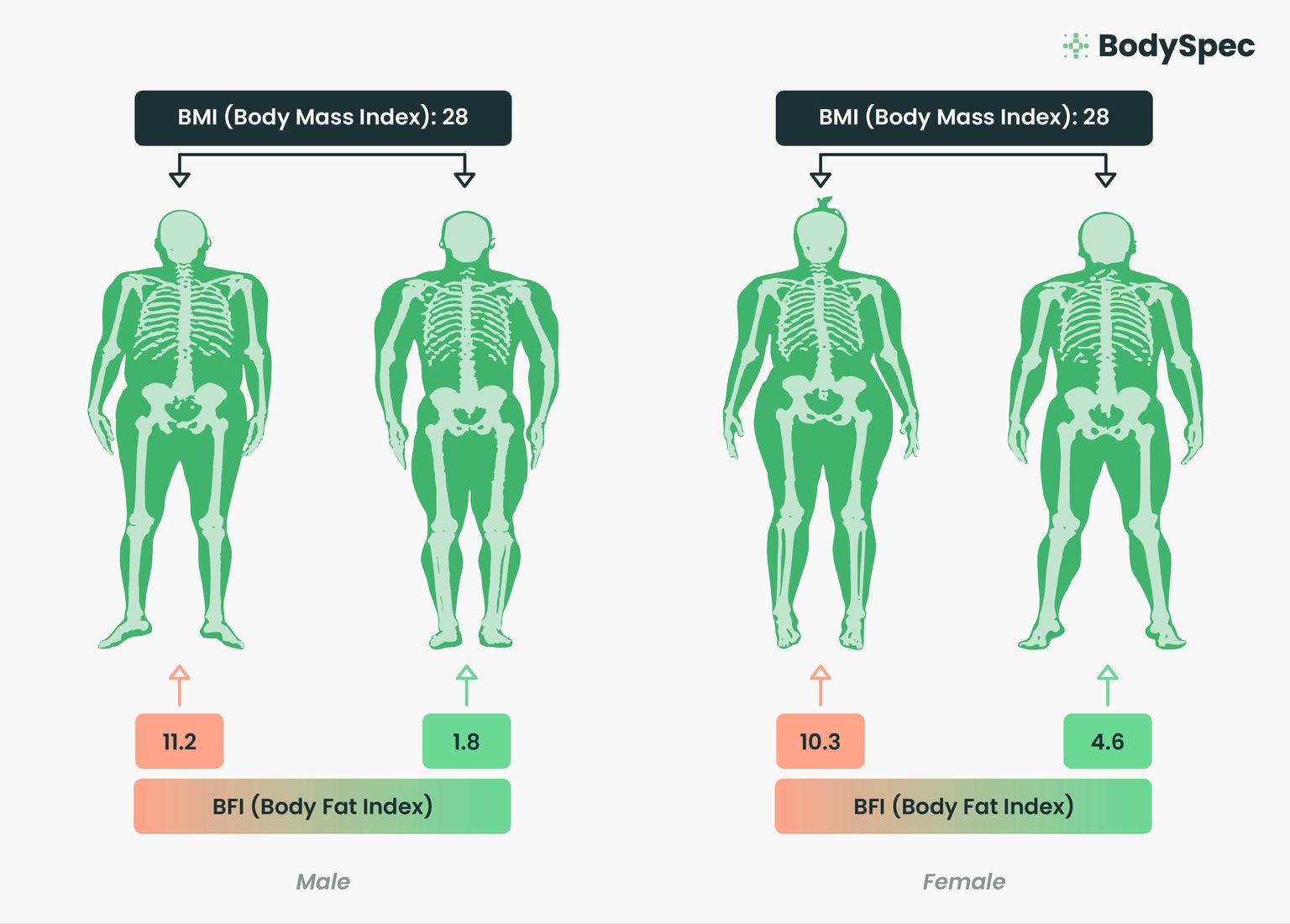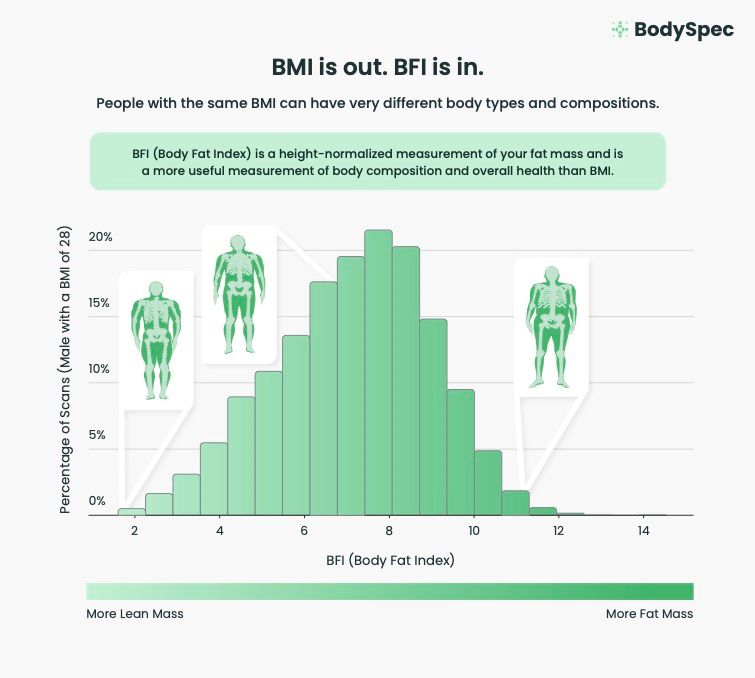BMI is out. BFI is in. Why BodySpec created a better way to measure your health.

It’s no secret that BMI is a flawed method for measuring our health. That’s why we developed a new metric called BFI (body fat index) that measures body fat relative to height. Integrating data from over 100,000 clients, BFI is a better measurement of body composition and overall health than BMI.
BMI: A Flawed Metric for Measuring Health
Body mass index (BMI) is used as the standard method to measure health in the US. The formula for BMI is your weight in kilograms divided by your height in meters squared. Your BMI is then categorized as underweight, healthy, overweight, or obese. However, in recent years, BMI has been questioned as a reliable metric for health.
In June 2023, the American Medical Association declared that BMI is an imperfect method to measure health because it does not account for age, gender, and ethnicity. Although BMI is widely accepted as a flawed metric, we continue to use it in our healthcare systems and media dialogue.
BMI fails to accurately measure our risk of chronic disease and alert us to health risks. With over two-thirds of the U.S. population either overweight or obese, we are facing a major public health crisis. Heart disease, diabetes, and other chronic conditions are at all-time highs, driving 7 out of 10 deaths in the US. However, even people with a “normal” BMI can be at risk for metabolic disease. We need a better system to combat these dangers.
Get weekly updates.
BMI: What's Missing?
1. Limited Assessment of Body Composition
BMI fails to differentiate between muscle mass and fat. These two elements have vastly different health impacts. For example, muscle mass is associated with positive health outcomes, while excess fat is linked to a higher risk of metabolic disease and cancer. It does not account for variations in bone density or lean muscle, which can significantly impact an individual's health.
2. Ignoring Individual Differences
BMI disregards individual variations in body composition, metabolism, and genetics. Two people with the same BMI can have very different levels of body fat and risk profiles. For example, athletes with high muscle mass can be mistakenly labeled as overweight based on BMI. Because muscle is more dense than fat, their BMI is higher, even though they are still healthy.
3. Ethnic and Gender Variations
BMI does not adequately address variations in body composition among different ethnic groups and genders. For example, people of Asian descent may have a higher percentage of body fat at lower BMI values, putting them at increased health risks even with a "normal" BMI.
4. Overlooking Fat Distribution
BMI does not consider the distribution of body fat, which is important for determining health risks. Accumulation of fat around the abdominal area (visceral fat) is associated with a higher risk of cardiovascular diseases and metabolic disorders, even in individuals with a normal BMI.
5. Disregarding Lifestyle Factors
BMI does not consider other crucial lifestyle factors that contribute to overall health, such as diet, exercise habits, stress levels, sleep patterns, and mental well-being. These factors play a significant role in determining an individual's health status but are not captured by BMI alone.
BFI: A Better Measure of Health
BodySpec developed a new way to measure our health to prevent chronic disease. BFI (body fat index) is calculated by dividing your fat mass in kilograms by your height in meters squared. By including body composition data, BFI is a better representation of our health and our risk of chronic disease. Discover your BFI here.
Below are two pairs of people with the same BMI (28), separated by gender. However, the person on the left has a higher BFI, which means they have a greater amount of body fat relative to their height. In contrast, the person on the right has a lower BFI because they have less body fat relative to their height. Although both people have the same BMI (28), their actual body composition is completely different. The person with a higher BFI may have a greater risk of diabetes and heart disease because of their elevated levels of body fat. While both people have the same BMI, their BFI exposes hidden risk factors that can’t be seen with BMI alone.

It’s no secret that as we age, our body composition changes. Whether it’s driven by a sedentary lifestyle, hormonal fluctuations, or diet changes, all these factors impact our lean and fatty tissue ratios. Additionally, the diversity in our genome makes our human race beautiful. We are all different sizes, shapes, and our body compositions vary widely. Weight alone does not account for these variables or diversity, and it can mask underlying health conditions. This is why it’s so important to consider body composition (and BFI) to measure health risks.
Understanding BFI Ranges
To determine the impact of BFI, we’ve analyzed data from over 200,000 body composition scans from the BodySpec database. The graph below shows how BFI is distributed across a population of males with a BMI of 28. Although their BMI is the same, their body compositions vary widely. Each person’s body type (shown in the green scan images) is different depending on their BFI and their body fat percentage. Higher BFI values mean that you have more body fat relative to your height. A high BFI can alert you to health risks like metabolic syndrome, making screening for disease easier. Early detection saves lives, and BFI can be a valuable tool for preventive health.

Why BMI is out and BFI is in:
- BMI is an unreliable metric to measure our health. It does not account for differences in body composition, age, gender, and ethnicity.
- Body fat and lean tissue measurement are key to truly understanding our health and risk of chronic disease.
- BFI offers a better way to measure health risks because it considers body composition.
“We realized that all the data we collected could add so much value to the way we measure health risks,” said Roy Shi, CEO at BodySpec. “As we reflected on how we provided reports to our clients, re-thinking BMI was a no-brainer starting place. Knowing that our service can help people manage their risk of chronic disease is what drives us each day, and is core to our mission.”
Citations
Abramowitz, M. K., Hall, C. B., Amodu, A., Sharma, D., Androga, L., & Hawkins, M. (2018). Muscle mass, BMI, and mortality among adults in the United States: A population-based cohort study. PLOS ONE, 13(4), e0194697. https://doi.org/10.1371/journal.pone.0194697
Berg, S. (2023, June 14). AMA: Use of BMI alone is an imperfect clinical measure. American Medical Association. https://www.ama-assn.org/delivering-care/public-health/ama-use-bmi-alone-imperfect-clinical-measure
Davidson, K. (2020, October 29). Is BMI an Accurate Predictor of Health? Healthline. https://www.healthline.com/nutrition/is-bmi-accurate
Lee, D. H., & Giovannucci, E. L. (2018). Body composition and mortality in the general population: A review of epidemiologic studies. Experimental Biology and Medicine, 243(17-18), 1275–1285. https://doi.org/10.1177/1535370218818161
Macek, P., Biskup, M., Terek-Derszniak, M., Stachura, M., Krol, H., Gozdz, S., & Zak, M. (2020). Optimal Body Fat Percentage Cut-Off Values in Predicting the Obesity-Related Cardiovascular Risk Factors: A Cross-Sectional Cohort Study. Diabetes, Metabolic Syndrome and Obesity: Targets and Therapy, Volume 13(13), 1587–1597. https://doi.org/10.2147/dmso.s248444


